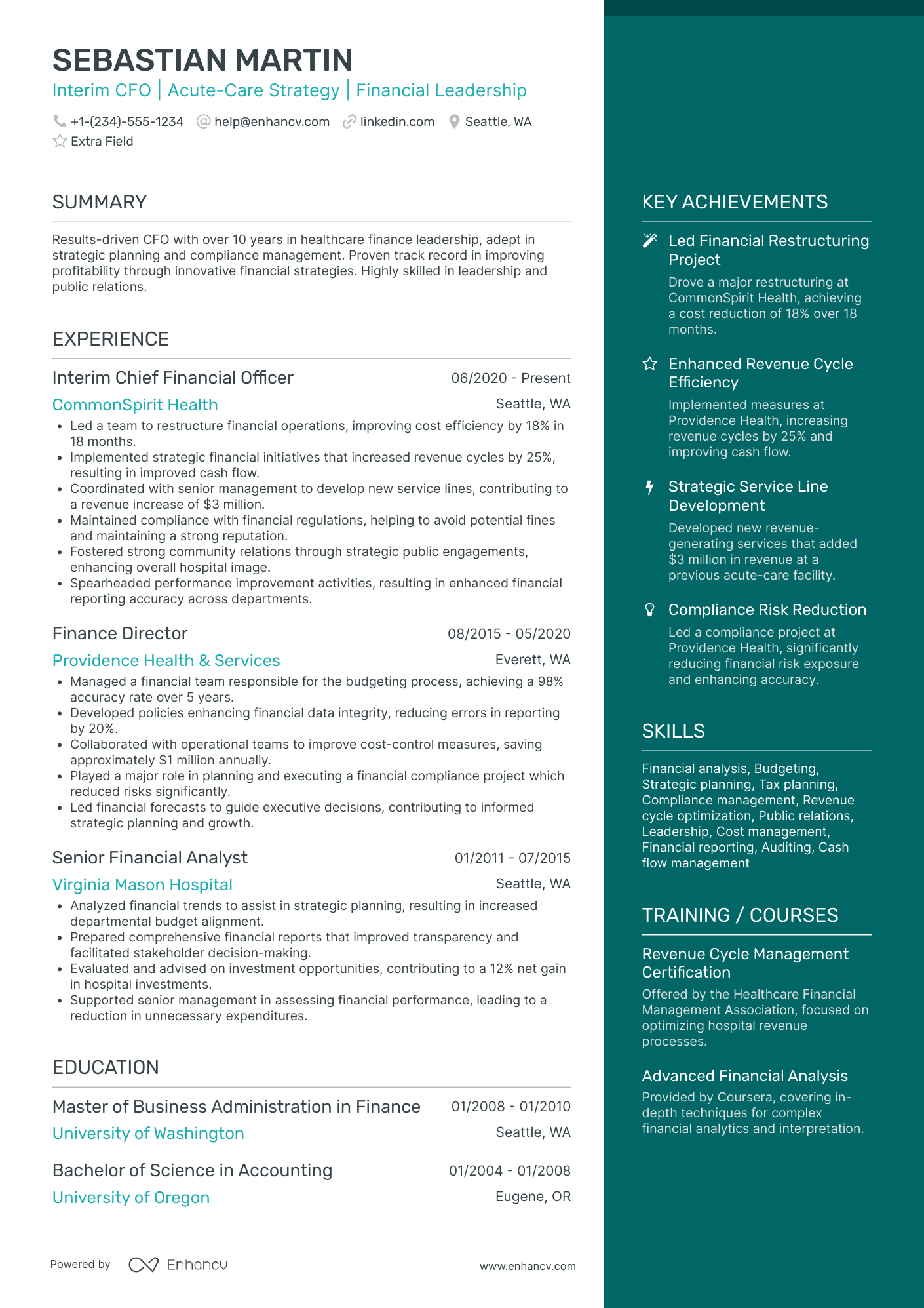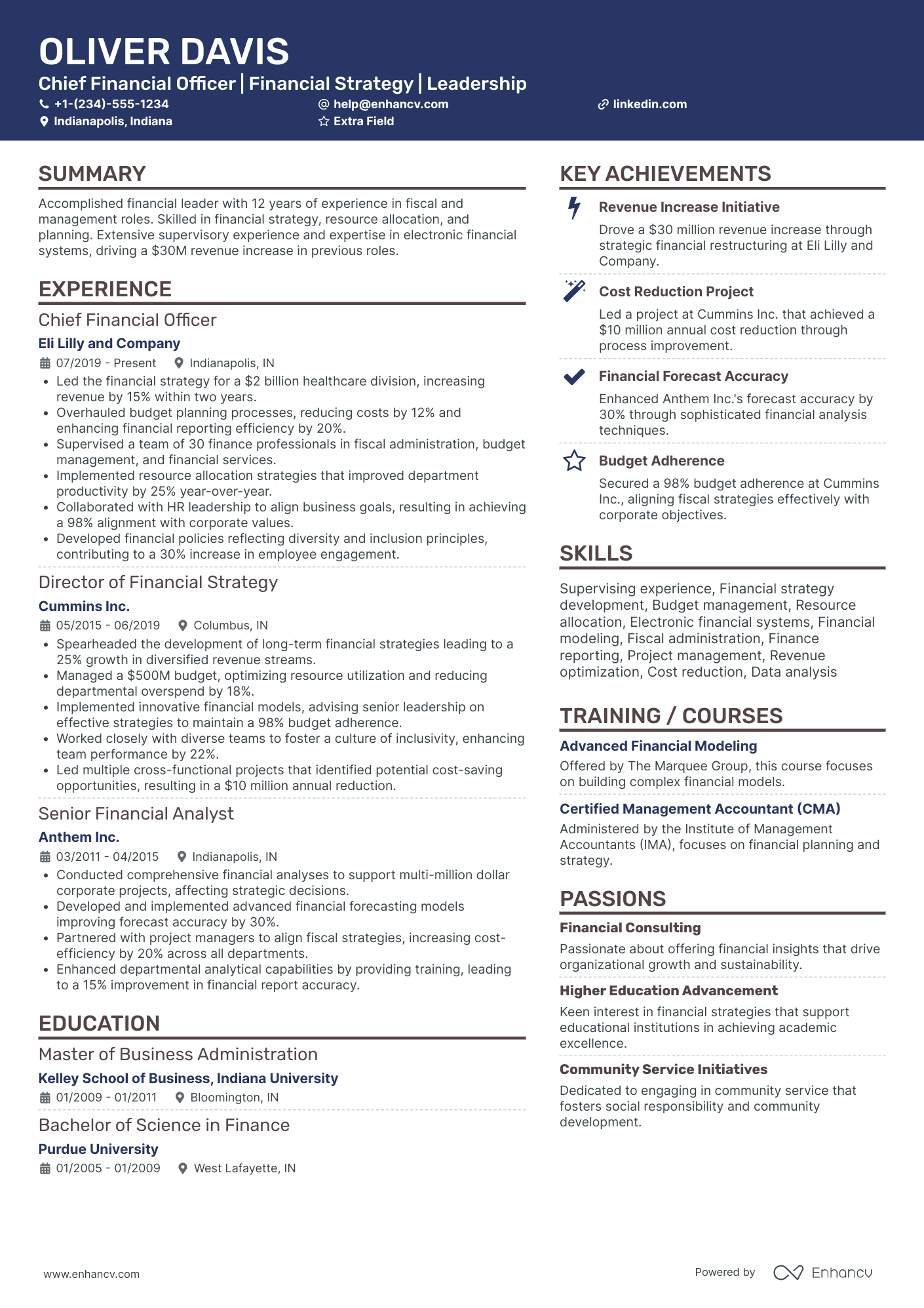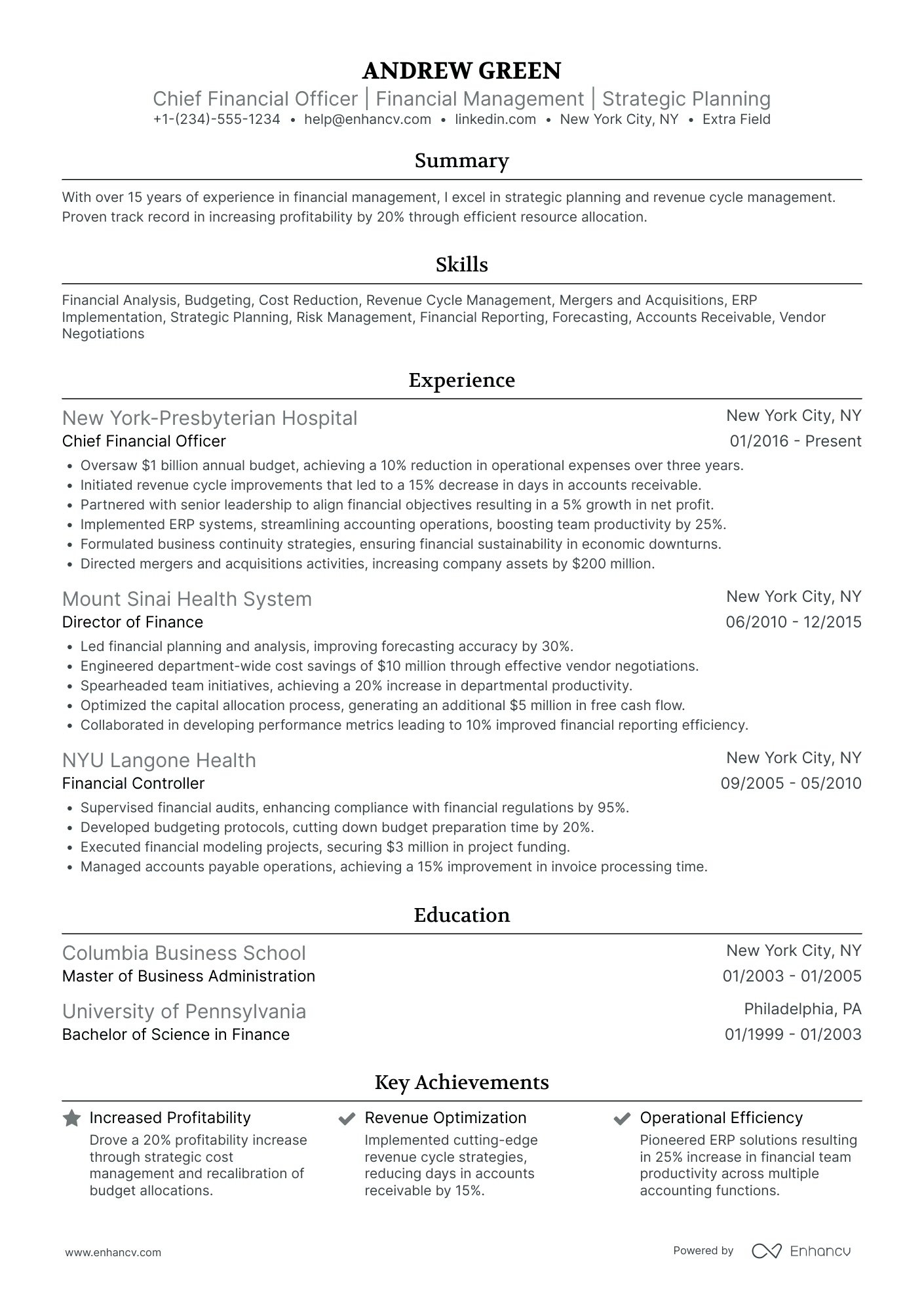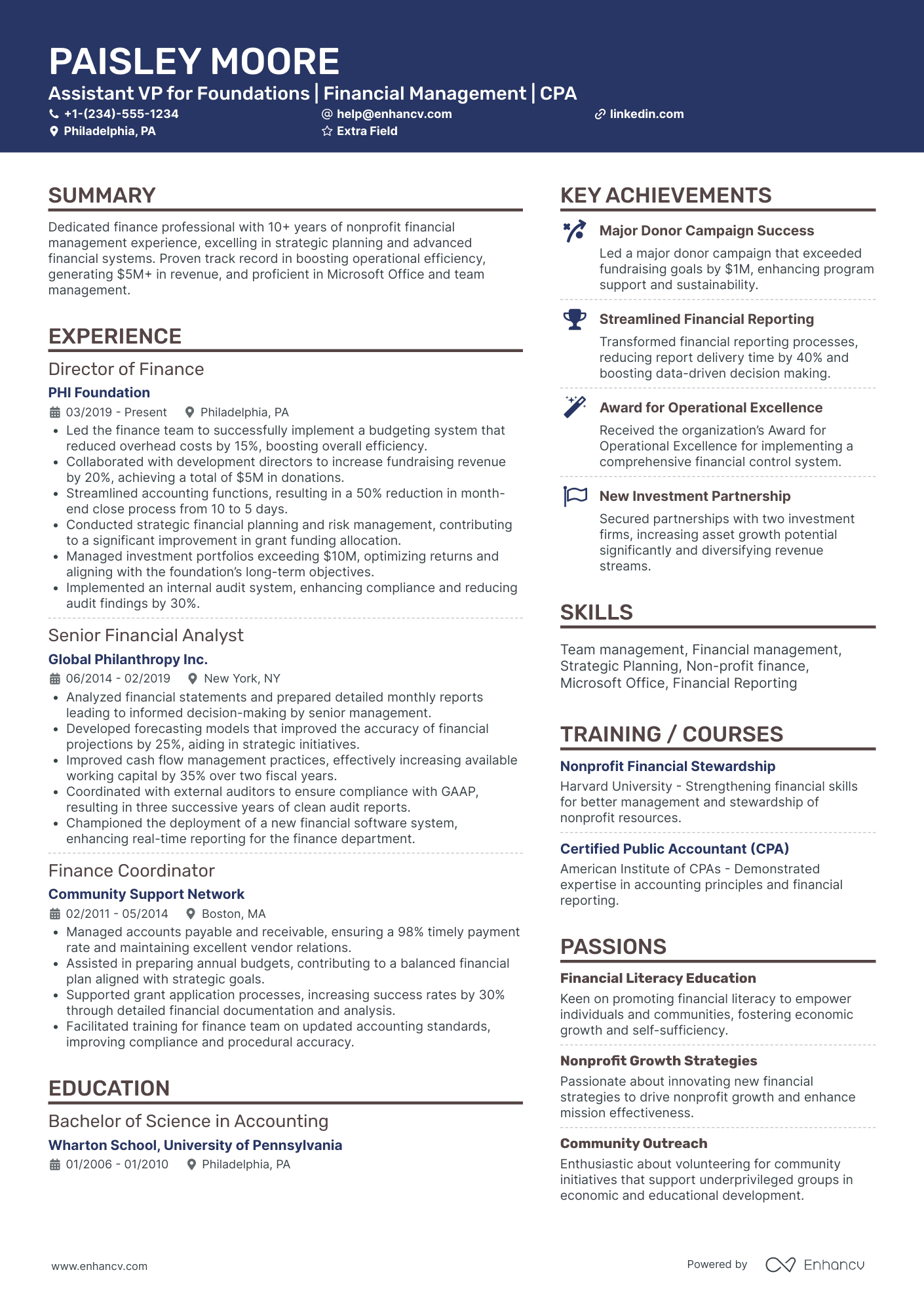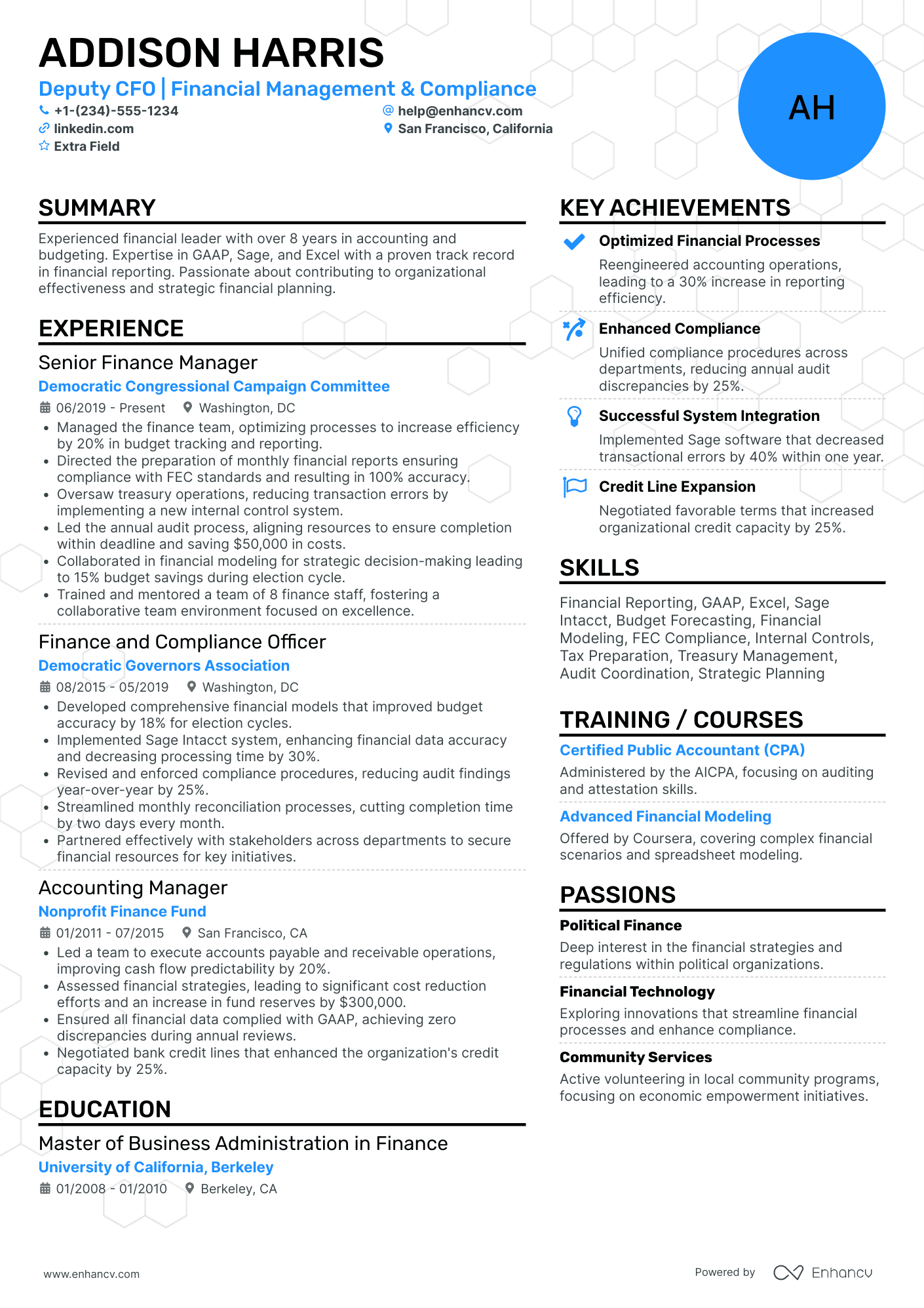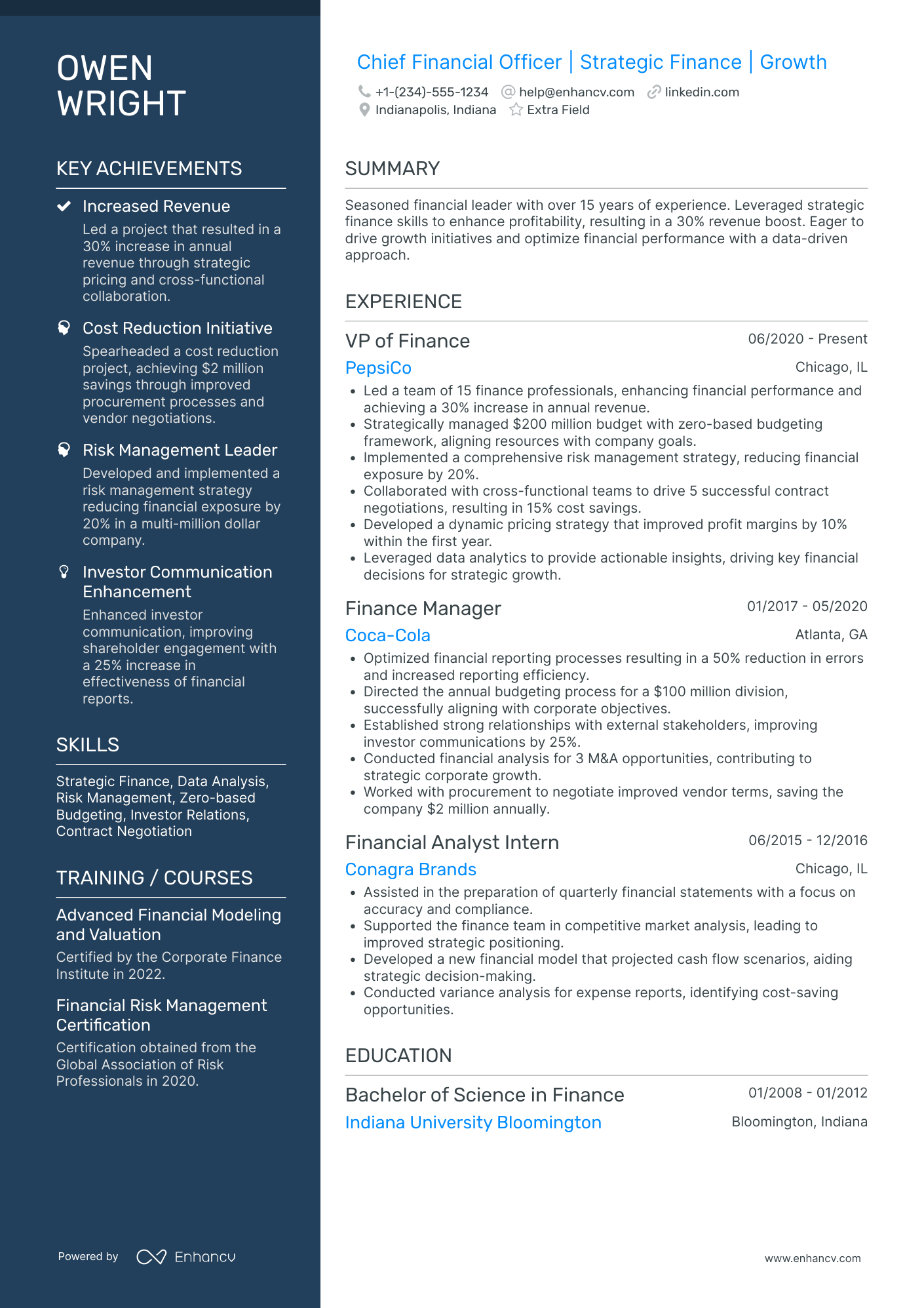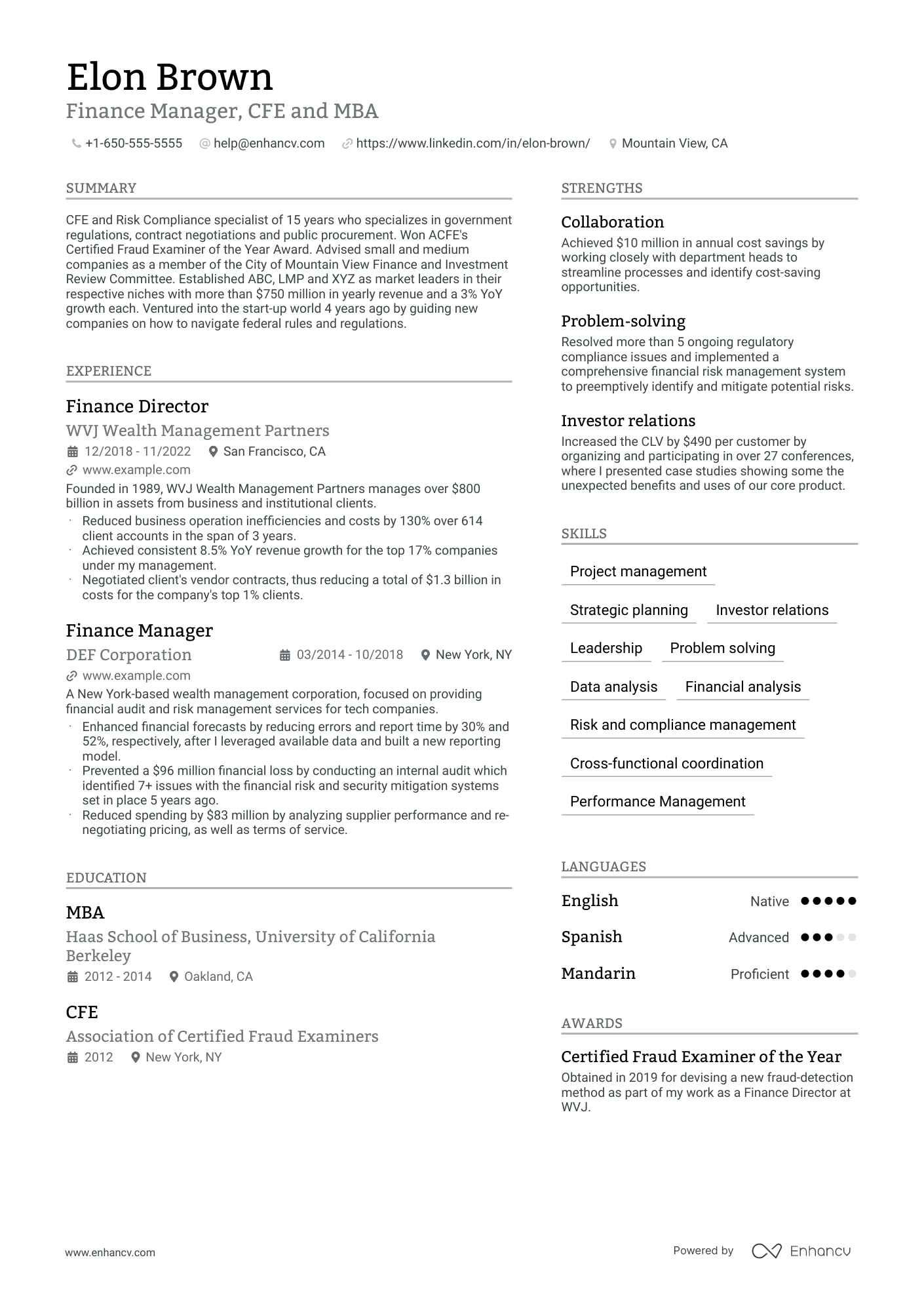Chief financial officers sometimes find it tough to highlight their wide-ranging skills in finance and leadership within a short resume.
Our CFO resume guide offers easy-to-follow strategies and examples, helping you communicate your significant talents and successes clearly and briefly, as well as how to:
- Use a standout CFO resume example that emphasizes the blend of strategy and operations.
- Showcase profit optimization and risk management success without overwhelming the reader.
- Underscore your modern toolset competence with a skills proficiency section.
- Point out your continued professional growth through certifications, workshops, or influential financial conferences attended.
Looking for a related resume instead? Bookmark these pages for later:
- VP of finance resume example
- Director of finance resume example
- Tax director resume example
- Treasury manager resume example
- CFO cover letter example
Cfo resume example that gets it right
Let’s discuss some helpful aspects of resume writing for a CFO role based on the given resume:
- Highlight Relevant Certifications and Achievements: "CFE and Risk Compliance specialist" and "Won ACFE's Certified Fraud Examiner of the Year Award" indicate specific certifications and awards directly related to finance and fraud examination.
- Quantify Achievements: Examples from the resume include: "Established ABC, LMP and XYZ as market leaders with more than $750 million in yearly revenue," "Reduced business operation inefficiencies and costs by 130%," and "Achieved consistent 8.5% YoY revenue growth."
- Showcase Specific Financial Skills and Expertise: "Enhanced financial forecasts by reducing errors," "Prevented a $96 million financial loss," and skills like "Financial analysis" and "Risk and compliance management" emphasize the candidate's financial acumen.
- Highlight Cross-Functional Collaboration and Results: Under strengths, "Achieved $10 million in annual cost savings by working closely with department heads" demonstrates the ability to work cross-functionally and achieve tangible results.
How to decide on a suitable format for your cfo resume
Nobody becomes a C-suite executive in a day. Unless you have a rich family who has a spare company in need of a CFO.
This means you already have at least 7-8 years of experience under your belt. As such, the reverse-chronological resume format is your best chance to showcase what you can do.
Alternatively, if most of your experience consists of:
- Being a board member or advisor of different committees
- Operating as a financial manager and advisor to companies in different business niches
- Mix of financial positions at both nonprofit and for-profit companies
…you can use the hybrid resume format. This layout will help you display a versatile skills set, while boasting a variety of achievements.
If you’re applying for a CFO role for the first time, the hybrid resume can also provide enough space to share skills developed outside of formal job roles.
But remember, this is an executive-level position. Both hiring managers and C-suite professionals prefer more traditional formats.
Now, what about document types and formatting? A few weeks ago, we set out to test how different resume layouts perform with various ATS tools.
Here is what our research found out:
- Header: The resume header contains your basic information, as well as links to your portfolio. Think of it as the business card you give to potential clients and partners.
- File Format: You can send your resume both as an MS Word and a PDF file. But PDFs are preferable because they preserve the design, format and stylings you’ve used.
- Section Headings: ATS software is sensitive when it comes to section headings. You must explicitly state what each section of your resume contains.
- Length: You may be tempted to include every single past role you’ve held. This is where editing is key. Let the job ad guide you. Try to fit within a page.
- Colors and Design: As we mentioned above, when reviewing executive-level resumes, recruiters look for a more traditional and conservative look.
- Fonts: Keeping it traditional doesn’t mean you have to use Times New Roman. ATS tools accept all of the popular Google fonts, so don’t hesitate to choose one you like.
If you’ve already been more than 10 years in the workforce, be selective about the experience you share. After all, you don’t want a three- (or more) page-long resume.
Feature only relevant entries and try not to go back further than a decade.
Keep in mind market-specific formats – for example, a Canadian resume might follow a different structure.
Pro tip
If you want your resume to look conservative, yet not bland, use your potential employer’s brand colors. But don’t go overboard with the overall design.
Wondering if your resume passes through the ATS checkers? Have a look-see below:
Is your resume good enough?
Drop your resume here or choose a file. PDF & DOCX only. Max 2MB file size.
The top sections on a CFO resume:
- Professional Experience and Achievements: Shows the candidate's progression, key roles, and significant contributions specific to financial leadership.
- Education and Certifications: Lists relevant degrees and financial certifications, validating the candidate's specialized knowledge.
- Skills and Financial Expertise: Highlights specific financial proficiencies, from strategic planning to risk assessment, essential for a CFO role.
- Board Memberships and Affiliations: Indicates involvement in strategic decision-making beyond day-to-day operations and showcases industry influence.
- Endorsements and Recommendations: Offers third-party validations of the CFO's capabilities, achievements, and leadership qualities.
What recruiters want to see on your resume:
- Proven track record in strategic financial planning and execution: They've shown they can make smart money plans and follow through with them for a company.
- Experience in mergers, acquisitions, and corporate restructuring: They know how to help companies join together, buy other companies, or change their setup to work better.
- Demonstrated leadership in capital management and fundraising: They're good at handling a company's money and can find ways to get more money when needed.
- Proficiency in risk management and regulatory compliance: They make sure the company follows money rules and avoid risky situations.
- Board-level interactions and influence in corporate decision-making: They can talk with top people in a company and help make big decisions using their money know-how.
Curate the experience section of your chief financial officer resume
You’ve already featured some of your accomplishments in the summary to grab recruiters’ attention. But your job is not done here.
There’s nothing worse than starting with a bang only to have things fizzle out by the time hiring managers get to the most important part of your resume.
Your goal is to explain how your career has progressed so far and where you see yourself in the future. Each experience section entry consists of the:
- Name of your employer with a short description, outlining its business focus.
- Company’s website
- Job title you held during your tenure
- Dates of your employment or your participation in a particular project. Note that consistent formatting is crucial to pass the ATS tests.
- No more than 5 bullet points accentuate how your efforts have contributed to your employers business goals.
The best way to emphasize the impact of your work is by quantifying it. Lead each bullet point with an action verb, then explain the challenges you’ve managed to overcome.
However, it’s difficult to quantify without revealing proprietary information. Here are our tips on how to put measurable achievements and not worrying about NDAs:
- Use Relative Metrics Over Absolute Numbers: Instead of specifying exact numbers (e.g., "Saved $5M in operational costs"), use relative metrics (e.g., "Reduced operational costs by 15%").
- Benchmark Against Industry Standards: Comparing your company's performance against industry benchmarks can provide context. For instance, if the industry average for revenue growth is 5%, and your company achieved 12%, it shows your company is outperforming the industry.
- Use Graphs and Visual Representations: Graphs can depict growth or reductions without necessarily revealing the exact numbers. For instance, a line graph showing upward revenue growth over a 5-year period gives a visual idea of performance without disclosing specifics.
- Highlight Achievements in a Contextual Manner: If you launched a new financial system that led to cost savings, mention it as "Implemented a state-of-the-art financial system that resulted in significant operational efficiencies."
- Avoid Sensitive Data: Refrain from disclosing information that could be used by competitors or adversely affect stock prices. For instance, you can avoid specifics about debt financing or mention mergers and acquisitions without revealing terms.
- Use Aggregated Data: Instead of breaking down data by business unit or department, provide an overall figure. This can show the impact without revealing too much detail.
- Highlight Awards and Recognitions: If your company or finance department has been recognized by industry bodies or has received awards, use them to validate your achievements without having to dive into sensitive specifics.
- Discuss Training and Implementation: Highlighting the implementation of new training programs, software, or tools and their impacts ("Introduced a new financial modeling tool that improved forecast accuracy by 20%") showcases leadership and innovation.
Make sure you:
- List your entries in a reverse-chronological order
- Stay relevant to the job description
- Don’t include positions you’ve held more than 10 years ago
Use the following sample experience section as a reference:
- •Reduced business operation inefficiencies and costs by 130% over 614 client accounts in the span of 3 years.
- •Achieved consistent 8.5% YoY revenue growth for the top 17% companies under my management.
- •Negotiated client's vendor contracts, thus reducing a total of $50% of industry-average share in costs for the company's top 1% clients.
List a balanced mix of relevant chief financial officer skills
Why does your resume need a balanced skills section?
Because it proves that you are the well-rounded superstar fit for the position. You have to be able to communicate with both financial gurus and non-specialists.
To build it, will help you tailor your resume according to the job description.
First off, listing hard skills you have that match the job description will tick all the ATS relevancy checks. After all, it’s all about keyword targeting with ATS.
By contrast, the soft skills you cite will get you noticed by recruiters.
Let’s tackle the types of talents one by one. Starting with your technical abilities, we’ve created a list with the most popular CFO skills currently trending:
34 technical skills for a chief financial officer
- Financial analysis and reporting
- Financial forecasting and projections
- Financial planning and strategy
- Fiscal help
- Financial modeling
- Cash flow and tax management
- Cost management
- Data analytics
- Market analysis
- Revenue and profit growth
- Cross-functional coordination
- M&A
- Strategic business planning and execution
- Investment management
- Partnerships development
- Contract negotiation
- Stakeholder relations management
- Investor relations
- Information system management
- Risk compliance and management
- Regulatory compliance
- SEC
- SOX
- GAAP
- Standards and practices
- Performance management
- SQL
- Python
- Database management
- QuickBooks
- FreshBooks
- QlikView
- Hyperion/Oracle
- ERP
Most of these are easy to quantify. The other ones can be tested on the spot during the interview.
Yet, how do you describe your soft skills?
Soft skills showcase the impact of your professional efforts. Think about how your boss and colleagues talk about what you do.
Have you helped the company achieve its goals? Has your work shone the spotlight on your team? Does your work style inspire others around you?
Hiring managers are searching for leaders who can pull both the company and its employees up.
Again, you must be able to link your achievements to verifiable numbers. Use data and numbers to quantify the impact of your work:
By doing so, you show that you take your job very seriously and consider the consequences of your actions.
If you can’t think of any relevant social talents off the top of your head, we have some suggestions for you:
Necessary 30 soft skills for a chief financial officer
- Presentation skills
- Persuasion skills
- Explanation skills
- Communication skills
- Interpersonal skills
- Problem-solving skills
- Analytical skills
- Critical thinking
- Time management
- Organizational skills
- Task delegation
- Collaboration skills
- Leadership
- Results-oriented
- Data-driven
- Adaptability
- Flexibility
- Resourcefulness
- Creativity
- Accuracy
- Consulting skills
- Being innovative
- Being confident
- Hard working
- Accountable
- Responsible
- Multitasking skills
- Being able to think outside the box
- Fast learner
- Ability to work in a stressful environment
How to list your certifications and education on your resume
The education section on a CFO's resume is valuable for several reasons:
- Foundational Knowledge: The complexities of financial management, strategic planning, and risk assessment often require a solid educational foundation. A degree in finance, accounting, business, or a related field provides this foundation.
- Credibility: Holding a degree from a reputable institution can lend credibility to the CFO's qualifications. For senior-level roles, a master's degree (like an MBA or Master's in Finance) or higher can be seen as particularly prestigious.
- Specialized Training: Apart from generic degrees, specialized training or certifications (like CPA, CFA, etc.) indicate expertise in specific areas of finance. These can be instrumental in certain industries or roles.
- Continuous Learning: Listing additional courses, workshops, or seminars attended indicates a commitment to continuous learning and staying updated with the latest industry trends and practices.
- Transferable Skills: Some educational backgrounds, even if not directly related to finance, can offer transferable skills valuable for a CFO. For example, a degree in law can be beneficial for a CFO dealing extensively with regulatory compliance.
While experience, skills, and accomplishments play a paramount role in a CFO's qualifications, the education section complements and reinforces the individual's suitability for the role.
So, here’s what your resume education should look like:
- Degree and Major: Clearly state the type of degree (B.A., B.S., M.B.A., Ph.D., etc.) and the major or specialization.
- Example: M.B.A. in Financial Management
- Institution Name: Mention the university or educational institution's name.
- Example: Harvard Business School
- Graduation Date: You can choose to include the year of graduation. Some choose to omit this to avoid potential age bias.
- Example: Graduated in 2020
- Honors or Achievements: If you graduated with honors or any special recognition, mention it.
- Example: Summa Cum Laude
- Specialized Courses: If you've taken specific courses that are especially relevant to the CFO role or the industry you're applying to, list them.
- Example: Advanced Risk Management Course
- Thesis or Major Projects: If your thesis or a significant project has relevance to the position or showcases your expertise, it can be worth mentioning.
- Example: Thesis on "Strategic Financial Forecasting in Tech Start-ups"
- Professional Development: Workshops, seminars, or short courses that enhance your qualifications.
- Example: Financial Leadership Workshop at Stanford University
- Associations or Clubs: If you were part of finance or business-related student organizations or clubs, it could highlight leadership or active involvement in the field from an early stage.
- Example: President, University Finance Club
Remember to list the items in reverse chronological order, starting with the most recent educational achievement. Tailor the education section to the specific role and company to which you're applying, highlighting the most relevant educational accomplishments.
Here’s an example of how to do that:
- •Summa Cum Laude
- •Thesis on Strategic Financial Forecasting in Tech Start-ups
- •President, University Finance Club
Outline your chief financial officer certificates
Finance and accounting is a huge academic and professional field. You can’t possibly specialize in everything, unless you dedicate your life to it.
This is where certifications come in handy. They show where your focus lies and how you want to continue developing professionally.
And your resume’s certifications are what makes you stand out among other job candidates. When talking about your qualifications, mention the:
- Name of your certificate
- Validity date, if applicable
- Year you’ve obtained the document or projected year of completion
- Name of the college, university or international organization, issuing the diploma
Some of these include:
8 prestigious certifications for your CFO resume
- Certified Management Accountant (CMA)
- Chartered Global Management Accountant (CGMA)
- Certified Public Accountant (CPA)
- Chartered Financial Analyst (CFA)
- Financial Modeling & Valuation Analyst (FMVA)
- Certified Treasury Professional (CTP)
- Certified Information Systems Auditor (CISA)
- Certified Government Financial Manager (CGFM)
Build a convincing cfo resume summary
Serving as a CFO means that both your financial and your sales skills are on par with current standards.
One of the top skills for a salesperson is persuasion. And this is what your resume summary must do for you, if you want to impress your potential employer.
Explain why you are the best fit for the position and highlight some relevant achievements to support your claims.
The basic structure of a resume summary is as follows:
- Start with how many years of experience you have as a financial specialist.
- Continue by sharing your proudest work achievements
- Finish off by detailing your professional qualifications and skills you excel at
- To make an even greater impact, don’t go over 100 words or roughly 5-6 sentences.
This will make it easy for you to pick which accomplishments to share, but also easy-to-read for recruiters.
Moreover, by naming your key talents and tools as the job description does, you’ll increase your chances of passing the ATS tests.
Think of the ATS software as a matchmaking tool. It checks whether the skills you’ve mentioned match the one in the job ad.
Check out some good examples we have prepared for you below:
Add some character to your resume by attaching other sections
Another way to impress hiring managers is to dedicate some space for other sections on your resume.
Being a C-level executive means that your professional activities don’t stop at working as a Finance manager. The ability to network and stay on top of industry trends is key.
As such, some relevant sections you can incorporate are:
- Association memberships (ACCFO, AICPA, AAA, IIA, AFA, etc.)
- Side projects, publications, and papers
- Clubs, passion projects, and honors
- Hobbies (for instance, networking and team building sports, such as golf)
Key takeaways
- Choose the reverse-chronological format as your resume layout;
- Include your professional titles, such as CPA or MBA in the resume header;
- Turn your resume summary into a sales pitch by flaunting your best achievements;
- Curate the experience section and tailor it to the job description;
- Create a good balance between the social and technical skills on your resume;
- Diversify your resume with additional CFO-relevant sections.
Chief Financial Officer resume examples
By Experience
